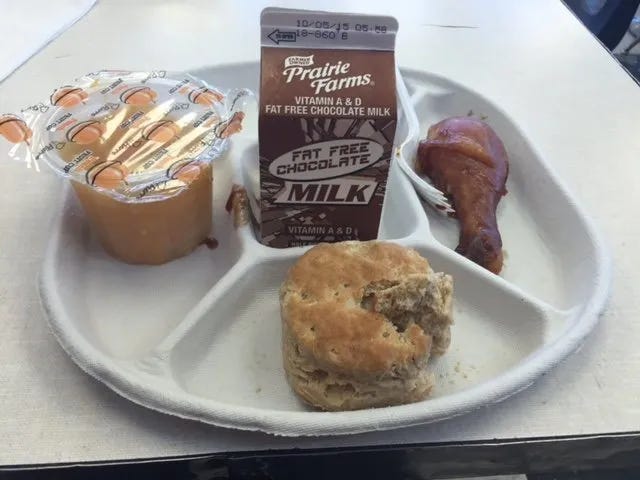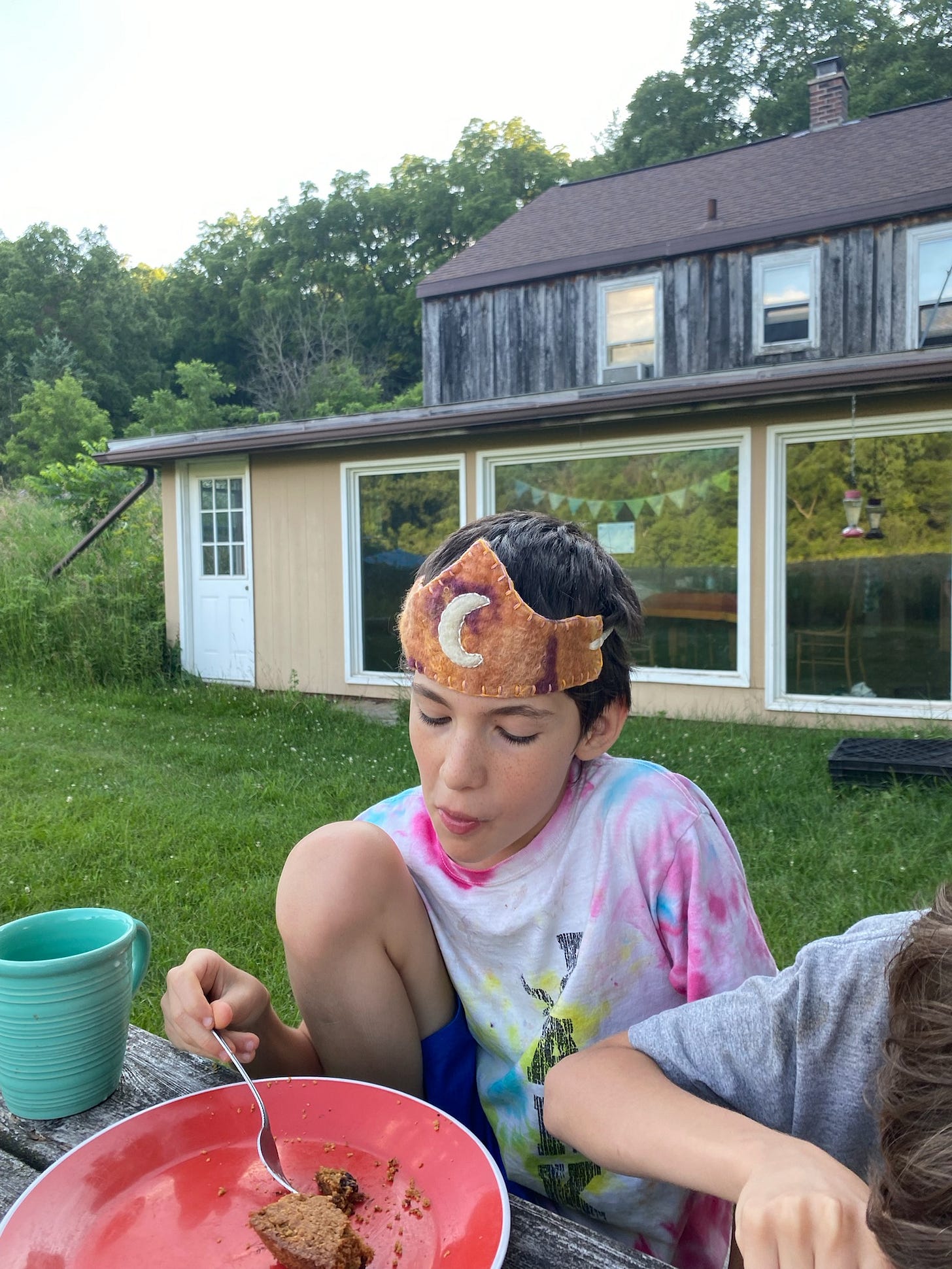
This past year, during our mild crisis of what-are-we-going-to-do this season, and after Alex turned down doing another season managing the farm in the Hudson Valley, we went for an interview to manage a non-profit farm in the upper northeast.
After having several phone conversations, they offered to fly us out there from Chicago, even the kids, to visit the farm. They wanted us to tour the private Waldorf school nearby too—they would pay for the boys’ tuition, which was part of the package deal. It was, really, an amazing opportunity. I had ALWAYS wanted the boys to attend a Waldorf school, but it had always been a too-expensive, unattainable pipe dream.
We did decide to go out and have an in-person interview, visit the farm, sleep over at the housing provided for the farmer, and tour the school. (We declined to let them fly us out, though, since I felt too weird—guilty?—about it.) We drove the 16-hour drive to probably the most idyllic looking farm I had ever seen. We toured the school, which was, of course, made up of beautiful wooden buildings deep in a forest setting with mountain views everywhere.
We went into the school buildings, where everyone seemed to be rehearsing for a play to perform (“We do LOTS of plays here!” chirped our tour guide, which of course made River shoot me a look that said, “I definitely want to go here”, and Huck to shoot me a different look of sheer stage-fright panic). We also saw where the kids ate lunch: an all-organic lunch every day was provided, where the kids had harvested many of the vegetables and fruits themselves, right on the premises. We had toured this school on the last day we were there, and though I had thought I would fall in love with it, the tour just made me sad. Not sad that we wouldn’t be attending (we had already decided the farm was too far away from either of our families and any of our friends, plus a few other factors made it not the right fit for us), but sad that not all kids had this kind of lunch every day. The creeping negative feelings of it’s-not-fair started to seep from my mind when I thought of countless public school children who were at the mercy of Tyson foods or General Mills to fill their bellies, while only the wealthy (this school cost $16,000 a year, per kid) could afford a plate with lightly cooked vegetables, grass-fed meat and heirloom grains.
This newsletter is not breaking any news by saying our food system is not just a little broken, but crushed-by-a-boot shattered. The US leads the way in industrial agriculture—many countries across the world wouldn’t dream of the pesticides and herbicides we allow in, the GMOs we plant, and the processing we do. And unfortunately for plenty of public school kids, the National School Lunch Program has gone in the wrong direction for years, slashing budgets and shrinking kitchens in schools to accommodate more heat-and-serve packaged foods of processed junk. This has been the unfortunate trend, but little by little, I believe there is ripe foundation for change, though it is neither simple nor easy.
At our farm, we donated tons and tons of produce and sometimes eggs to local food banks. I know full well that a farm produces a lot of extra food, food that can go into schools. Not that the farmer doesn’t need to be paid—they do. This is why the budgets at schools need to grow, to be able to pay for this food, upgrade kitchen cooking equipment, and hire people to cook wholesome meals. It is daunting, considering the uphill battle to make this happen, but it is possible. In Japan, nutritious food is already built into the public school system. Lunch is set in many classrooms as part of the curriculum, teaching traditional cooking methods and using seasonal, whole foods to cook from-scratch meals. It is a far cry from processed chicken tenders and white bread served on a plastic tray.
Finland and Sweden are just a couple of other examples with progressive school lunch programs, providing free lunches, often consisting of whole foods stews, steamed vegetables, salads, whole-grain bread and a side of fish or beans or meat, all supporting small farms. Fruit is usually given as the dessert.
In the US, there are some shining examples: Alice Waters’ famous Edible Schoolyard in Berkley was created by Waters finding an abandoned lot and growing food for a school, eventually having it incorporated into the teachings as well as the lunches. It is an idea that has been replicated by many schools, and their website has some great free lessons and information for curriculums. (Waters was the one that taught me about “dipping salads” that are served in many of these schools: chunky vegetables, like big leaves of lettuce, to be dipped in a simple dressing of oil and vinegar and eaten with your hands.) Likewise, Ann Cooper started her program in Colorado, and it has spun into a movement where different schools have done similar things. She has some great, free resources on her site as well.
Until there is a nationwide government program to make healthy, whole lunches mandatory for schools, school districts and people in charge of school budgets are the ones to make this a priority. Sometimes, it really does, unfortunately, start slow, and with the elite as a model; many private schools prioritize good food being served because they have the funding for it. Like Waldorf, farms are a very important part in the Montessori teaching philosophy, and many private Montessori schools have their own every day farm-to-table lunches. But public schools and districts are cash-strapped, and the ability to push the needle forward is an incredible challenge for many of them.
My grandmother liked to say that I “liked a challenge”. When I first heard from my mom that she said this about me, I was unsure that was true; I liked things easy, didn’t I? I want a life that is not difficult! But I think she was right, and this is what she meant; when I toured the Waldorf school in the northeast, all I could walk away with was, I wish this was the way it was for public schools. I wish all kids could eat a lunch like that, fresh vegetables from a garden and chicken from a farm and organic heirloom beans, cooked in broth. All kids at every school deserve to eat healthy food. I decided that paying for a fancy school (even if I was not the one paying for it) was not the way to make any kind of miniscule change. Somehow, touring this school didn’t really make me excited to put my kids into it; it just made me want to put the boys into a public school, one that I can possibly get involved with, one where I might be able to start, slowly, volunteering and working my way up to piece together the broken food system within. It can start with a small garden, an outdoor classroom, or growing food from our (eventual) farm that we might be able to supply a school with.
The complexities and crux of the issue of getting school lunches to be health-building meals is, of course, rooted in money. It is convoluted and difficult to fix, but we need to start somewhere, and just need to take the hit and prioritize it. Alice Waters says that “the cafeteria is the heart of the school”, which I love and have thought about often; what, after all, is more important than building healthy bodies to house those educated minds, in order to be able to go out into the world and do great things? We have to start somewhere, even if it is just an apple a day on an otherwise plant-less lunch tray.
From the Farmhouse:
Well, speaking of school, we are summer homeschooling since we homeschool year-round (so we can take breaks in the winter). This fall, as per my plan, I was going to enroll them in the local public school. The closest public school, which was only 8 minutes away, closed permanently right before we moved in (wah-wah, the sad trombone is basically the soundtrack of my life). Supposedly, it was a very sweet public school, with lots of potential, so that was a major bummer. The nearest other school is 20 minutes away and has not had great recommendations. One person, a former teacher there, told me she would never enroll her own kids there. So, yeah, I have had to really think that through! It feels ok, though, since I came up with a plan B and am, for this year, doing a hybrid of homeschool and virtual classes (basically so I can stop being frustrated with teaching them math) with this free, public online charter school. (Yes, a free Waldorf charter school!). Even though I was looking forward to them going to a school and not panicking about socialization this year, I think it will be fine for now, since there is a good chance we might be farming somewhere else next season, and we don’t have to disrupt anything this way if that happens and we have to move again. I will have to wait to become the Rebel Lunch Lady of my dreams, therefore. For this year, however, I will be, once again, the lone cafeteria worker for these two boys.
From the Farm Kitchen:
Not sure if I mentioned this, but we do a community potluck every week here at Rock Ridge. One of the members in vegan, so I am making lots of vegan meals, like the lentil dal with kale and zucchini I am making tonight. The boys and I are working on the community garden here, and also have been volunteering to care for the 4-H garden that provides free food for the town’s food bank (which we are also able to occasionally glean from). I can hardly wait for tomatoes to come in (yes, I know, Illinois and Michigan, you already have yours! But Wisconsin is still waiting for that flush!). I have a few recipe ideas for this Thursday’s newsletter, so stay tuned!






